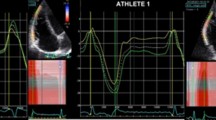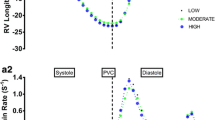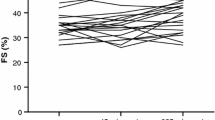Abstract
Purpose
There is contradictory evidence related to the impact of ultra-marathon running on right ventricular (RV) structure and function. Consequently, the aims of this study were to: (1) comprehensively assess RV structure and function before and immediately following a 100-mile ultra-marathon in highly trained runners, (2) determine the nature of RV recovery 6 h post-race, and (3) document 12-lead electrocardiogram (ECG) changes post-exercise.
Methods
Echocardiography and 12-lead ECG were assessed in 15 competitors in a repeated measures design before and immediately after completion of the 2013 Western States Endurance Race. A subset of nine was reassessed 6 h into recovery. Standard echocardiography was used to determine RV size, function and wall stress. Myocardial speckle tracking (MST) provided peak, time to peak and temporal indices for RV longitudinal strain and strain rates (ε and SR).
Results
RV size was increased post-race (inflow tract 14 %, outflow tract 11 %, P = 0.004 and 0.002). RV wall stress was elevated by 11 % post-race. Peak RV ε was reduced by 10 % (P = 0.007) and significantly delayed post-race (P = 0.008). Most changes in RV function persisted at the 6-h assessment. Post-race there was an increase in the prevalence of right-sided ECG changes.
Conclusions
Completion of a 100-mile ultra-marathon resulted in acute changes in RV structure and function that persisted 6 h into recovery and are consistent with sustained exposure to an elevated RV wall stress. These findings were supported by right-sided changes to the 12-lead ECG.




Similar content being viewed by others
Abbreviations
- A′:
-
Late diastolic myocardial tissue velocity
- AP4CH:
-
Apical 4 chamber view
- ASE:
-
American Society of Echocardiography
- E′:
-
Early diastolic myocardial tissue velocity
- ECG:
-
Electrocardiogram
- EI:
-
Eccentricity index
- EICF:
-
Exercise-induced cardiac fatigue
- FAC:
-
Fractional area change
- HR:
-
Heart rate
- IVCT:
-
Isovolumic contraction time
- IVRT:
-
Isovolumic relaxation time
- LV:
-
Left ventricle
- MST:
-
Myocardial speckle tracking
- PASP:
-
Pulmonary artery systolic pressure
- PLAX:
-
Parasternal long axis view
- PSAX:
-
Parasternal short axis view
- PW:
-
Pulsed wave
- RA:
-
Right atrium
- RAD:
-
Right axis deviation
- RV:
-
Right ventricle
- RVAs:
-
Right ventricular systolic area
- RVH:
-
Right ventricular hypertrophy
- RVOT:
-
Right ventricular outflow tract
- RVSp:
-
Right ventricular systolic pressure
- S′:
-
Systolic myocardial tissue velocity
- ε :
-
Myocardial strain
- SRA:
-
Late diastolic strain rate
- SRE:
-
Early diastolic strain rate
- SRS:
-
Systolic strain rate
- SV:
-
Stroke volume
- TDI:
-
Tissue Doppler imaging
- T sPeak:
-
Time to peak strain
- T SRAPeak:
-
Time to peak late diastolic strain rate
- T SREPeak:
-
Time to peak early diastolic strain rate
- T SRSPeak:
-
Time to peak systolic strain rate
- TVI:
-
Tissue velocity imaging
Reference
Burns AT, Gerche AL, Prior DL, MacIsaac AI (2010) Left ventricular torsion parameters are affected by acute changes in load. Echocardiography 27:407–414. doi:10.1111/j.1540-8175.2009.01037.x
Chan-Dewar F, Oxborough D, Shave R, Gregson W, Whyte G, Noakes T, George K (2010) Evidence of increased electromechanical delay in the left and right ventricle after prolonged exercise. Eur J Appl Physiol 108:581–587
D’Andrea A et al (2012) Range of right heart measurements in top-level athletes: the training impact. Int J Cardiol. doi:10.1016/j.ijcard.2011.06.058 (in press)
Davila-Roman V, Guest TM, Tuteur PG, Rowe WJ, Ladenson JH, Jaffe AS (1997) Transient right but not left ventricular dysfunction after strenuous exercise at high altitude. J Am Coll Cardiol 30:468–473
Douglas PS, O’Toole ML, Hiller WD, Hackney K, Reichek N (1987) Cardiac fatigue after prolonged exercise. Circulation 76:1206–1213
Douglas PA, O’Toole ML, Hiller WDB, Reichek N (1990) Different effects of prolonged exercise on the right and left ventricles. J Am Coll Cardiol 15:64–69
George K et al (2005) Mitral annular myocardial velocity assessment of segmental left ventricular diastolic function after prolonged exercise in humans. J Physiol 569:305–313
George K et al (2009) Left ventricular wall segment motion after ultra-endurance exercise in humans assessed by myocardial speckle tracking. Eur J of Echocardiogr 10:238–243
Hart E, Shave R, Middleton N, George K, Whyte G, Oxborough D (2007) Effect of preload augmentation on pulsed wave and tissue Doppler echocardiographic indices of diastolic function after a marathon. J Am Soc Echocardiogr 20:1393–1399
Ho SY, Nihoyannopoulos P (2006) Anatomy, echocardiography, and normal right ventricular dimensions. Heart 92:12–13
Korinek J et al (2005) Two-dimensional strain––a Doppler-independent ultrasound method for quantitation of regional deformation: validation in vitro and in vivo. J Am Soc Echocardiogr 18:1247–1253
Kossmann CE et al (1967) Recommendations for standardization of leads and of specifications for instruments in electrocardiography and vectorcardiography. Circulation 35:583–602. doi:10.1161/01.cir.35.3.583
Kovacs G, Berghold A, Scheidl S, Olschewski H (2009) Pulmonary arterial pressure during rest and exercise in healthy subjects: a systematic review. Eur Respir J 34:888–894. doi:10.1183/09031936.00145608
Kucher N, Walpoth N, Wustmann K, Noveanu M, Gertsch M (2003) QR in V1––an ECG sign associated with right ventricular strain and adverse clinical outcome in pulmonary embolism. Eur Heart J 24:1113–1119. doi:10.1016/s0195-668x(03)00132-5
La Gerche A, Connelly KA, Mooney DJ, MacIsaac AI, Prior DL (2008) Biochemical and functional abnormalities of left and right ventricular function after ultra-endurance exercise. Heart 94:860–866
La Gerche A et al (2011) Disproportionate exercise load and remodeling of the athlete’s right ventricle. Med Sci Sports Exerc 43:974–981
La Gerche A et al (2012) Exercise-induced right ventricular dysfunction and structural remodelling in endurance athletes. Eur Heart J 33:998–1006. doi:10.1093/eurheartj/ehr397
Marcus JT, Gan CTJ, Zwanenburg JJM, Boonstra A, Allaart CP, Gbtte MJW, Vonk-Noordegraaf A (2008) Interventricular mechanical asynchrony in pulmonary arterial hypertension. J Am Coll Cardiol 51:750–757. doi:10.1016/j.jacc.2007.10.041
McKechnie J, Leary W, Noakes T, Kallmeyer J (1979) Acute pulmonary oedema in two athletes during a 90 km running race. South Afr Med J 56:261–265
Middleton N, Shave R, George K, Whyte G, Hart E, Atkinson G (2006) Left ventricular function immediately following prolonged exercise: a meta-analysis. Med Sci Sports Exerc 38:681–687
Mor-Avi V et al (2011) Current and evolving echocardiographic techniques for the quantitative evaluation of cardiac mechanics: ASE/EAE consensus statement on methodology and indications endorsed by the Japanese Society of Echocardiography. J Am Soc Echocardiogr 24:277–313. doi:10.1016/j.echo.2011.01.015
Neilan TG et al (2006a) Myocardial injury and ventricular dysfunction related to training levels among nonelite participants in the Boston marathon. Circulation 114:2325–2333
Neilan TG et al (2006b) Persistent and reversible cardiac dysfunction among amateur marathon runners. Eur Heart J 27:1079–1084
Oxborough D, Shave R, Middleton N, Whyte G, Forster J, George K (2006) The impact of marathon running upon ventricular function as assessed by 2D Doppler, and tissue-Doppler echocardiography. Echocardiography 23:635–641
Oxborough D et al (2010) A depression in left ventricular diastolic filling following prolonged strenuous exercise is associated with changes in left atrial mechanics. J Am Soc Echocardiogr 23:968–976. doi:10.1016/j.echo.2010.06.002
Oxborough D et al (2011) Dilatation and dysfunction of the right ventricle immediately after ultraendurance exercise exploratory insights from conventional two-dimensional and speckle tracking echocardiography. Circ Cardiovasc Imaging 4:253–263. doi:10.1161/circimaging.110.961938
Oxborough D et al (2012) The right ventricle of the endurance athlete: the relationship between morphology and deformation. J Am Soc Echocardiogr 25:263–271. doi:10.1016/j.echo.2011.11.017
Puwanant S et al (2010) Ventricular geometry, strain, and rotational mechanics in pulmonary hypertension. Circulation 121:259–266. doi:10.1161/circulationaha.108.844340
Rudski LG et al (2010) Guidelines for the echocardiographic assessment of the right heart in adults: a report from the American Society of Echocardiography endorsed by the European Association of Echocardiography, a registered branch of the European Society of Cardiology, and the Canadian Society of Echocardiography. J Am Soc Echocardiogr 23:685–713. doi:10.1016/j.echo.2010.05.010
Ryan T, Petrovic O, Dillon JC, Feigenbaum H, Conley MJ, Armstrong WF (1985) An echocardiographic index for separation of right ventricular volume and pressure overload. J Am Coll Cardiol 5:918–924. doi:10.1016/s0735-1097(85)80433-2
Sahlen A et al (2009) Cardiac fatigue in long-distance runners is associated with ventricular repolarization abnormalities. Heart Rhythm 6:512–519. doi:10.1016/j.hrthm.2008.12.020
Shave RE, Dawson E, Whyte G, George K, Ball D, Gaze DC, Collinson PO (2002) Evidence of exercise-induced cardiac dysfunction and elevated cTnT in separate cohorts competing in an ultra-endurance mountain marathon race. Int J Sports Med 23:489–494
Shave R et al (2004a) The impact of prolonged exercise in a cold environment upon cardiac function. Med Sci Sports Exerc 36:1522–1527
Shave RE, Dawson E, Whyte G, George K, Gaze D, Collinson P (2004b) Effect of prolonged exercise in a hypoxic environment on cardiac function and cardiac troponin T. Br J Sports Med 38:86–88
Stein PD et al (2013) Relation of electrocardiographic changes in pulmonary embolism to right ventricular enlargement. Am J Cardiol 112:1958–1961. doi:10.1016/j.amjcard.2013.08.030
Stewart GM, Kavanagh JJ, Koerbin G, Simmonds MJ, Sabapathy S (2014) Cardiac electrical conduction, autonomic activity and biomarker release during recovery from prolonged strenuous exercise in trained male cyclists. Eur J Appl Physiol 114:1–10. doi:10.1007/s00421-013-2742-4
Vitiello D, Rupp T, Bussiere JL, Robach P, Polge A, Millet GY, Nottin S (2013) Myocardial damages and left and right ventricular strains after an extreme mountain ultra-long duration exercise. Int J Cardiol 165:391–392. doi:10.1016/j.ijcard.2012.08.053
Acknowledgments
We would like to thank the Western States Endurance Run Foundation for their support with this study.
Conflict of interest
None.
Ethical standards
Ethics approval was granted by the Liverpool John Moores Ethics committee and the study complied with the current laws of the USA where the research was undertaken.
Author information
Authors and Affiliations
Corresponding author
Additional information
Communicated by Carsten Lundby.
Rights and permissions
About this article
Cite this article
Lord, R., Somauroo, J., Stembridge, M. et al. The right ventricle following ultra-endurance exercise: insights from novel echocardiography and 12-lead electrocardiography. Eur J Appl Physiol 115, 71–80 (2015). https://doi.org/10.1007/s00421-014-2995-6
Received:
Accepted:
Published:
Issue Date:
DOI: https://doi.org/10.1007/s00421-014-2995-6




